Planning a visit to the sprawling metropolis of Los Angeles? Understanding the local weather is absolutely crucial for packing appropriately, scheduling your activities, and ensuring a smooth and enjoyable experience, whether you’re exploring world-class museums, hitting the beaches, hiking in the hills, or trying out the diverse culinary scene. As a travel expert who believes in immersing in local culture and experiences, I know that anticipating the weather helps you truly live like a local. Let’s dive into what the los angeles weather forecast means for your upcoming adventures.
Los Angeles is famous for its Mediterranean-like climate, characterized by mild, wet winters and hot, dry summers. However, the los angeles weather can be surprisingly varied due to its unique geography, including mountains, valleys, and a long coastline. This creates distinct microclimates, meaning the temperature and conditions can differ significantly from one neighborhood to the next, sometimes by as much as 10-20 degrees Fahrenheit within a short distance.
Understanding these microclimates is key to navigating the los angeles weather. Coastal areas, like Santa Monica and Venice, often benefit from the cooling influence of the Pacific Ocean, leading to milder temperatures and occasional morning fog (known as the “marine layer”). Inland areas, such as the San Fernando Valley and parts of the Inland Empire, tend to experience much hotter temperatures, especially during the summer months, and colder nights in winter.
The forecast for the upcoming week indicates a cooler trend making its way across Southern California. A trough of low pressure is moving in, promising a welcome drop in temperatures after recent conditions. This shift often brings increased cloud cover and the return of the marine layer, which can sometimes produce a patchy drizzle, particularly in coastal and basin areas.
Tuesday is predicted to be the coolest day of the week under the influence of this weather system. Temperatures across most of the region are expected to hover mainly in the 60s and 70s Fahrenheit throughout the week. This is quite pleasant for exploring the city, whether you’re walking the Walk of Fame or visiting Griffith Observatory.
Looking further ahead towards the weekend, current models suggest the arrival of another cold front. This reinforces the cooler pattern and maintains the chance for some light precipitation. While heavy rain is uncommon in this type of pattern, a drizzle can sometimes add a unique atmosphere to the city, perhaps making a visit to an indoor market or a cozy cafe even more appealing.
For Los Angeles and Orange County specifically, Tuesday’s forecast high is expected to reach around 68 degrees Fahrenheit, with overnight lows dipping to approximately 53 degrees. By Wednesday, temperatures are anticipated to begin a gradual ascent, climbing back into the lower 70s, offering comfortable conditions for outdoor activities or enjoying a meal on a patio.
Valleys and the Inland Empire will see a high of approximately 71 degrees Fahrenheit on Tuesday, with lows around 49 degrees. These areas typically experience a wider temperature swing than coastal regions. Expect temperatures here to rebound more quickly on Wednesday, with highs projected to reach up to 76 degrees, making it still warm enough for lighter clothing during the day.
The Ultimate Guide to What to Eat in Austin Texas
Your Guide to the Michigan Map with Cities – Unlocking the Great Lakes State
Ultimate Guide to Weekend Trips From Las Vegas
Beaches along the coast can anticipate significant cloud cover on Tuesday, with a high temperature near 66 degrees Fahrenheit. The marine layer is likely to be a dominant feature here, potentially lingering throughout the day. Similar weather is generally expected to persist through the remainder of the week in these areas, perfect for a leisurely stroll along the shore or watching surfers.
In the mountains surrounding the Los Angeles basin, there’s a very slight chance of showers on Tuesday. Temperatures will be considerably cooler at higher elevations, with a high around 52 degrees Fahrenheit and a low dropping significantly to about 27 degrees. If you’re planning a mountain escape, layered clothing is essential.
The desert regions to the east of Los Angeles can expect gusty winds on Tuesday, with a high near 67 degrees Fahrenheit. While cooler than their typical heat, these areas will see a rapid warm-up later in the week, with temperatures projected to jump into the low 80s. This reminds us of the vast climatic differences within Southern California.
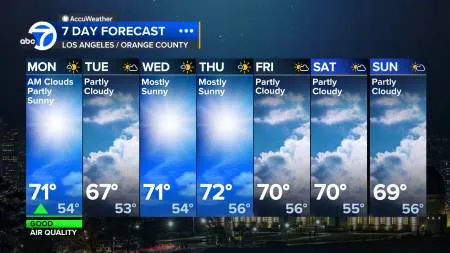 7-day los angeles weather forecast for LA and Orange County
7-day los angeles weather forecast for LA and Orange County
Understanding the general climate patterns of Los Angeles can also help in planning trips well in advance. The warmest months are typically July through September, often extending into October. December through February are usually the coolest months and receive the most rainfall, although the amount varies significantly year to year. Spring and fall offer perhaps the most pleasant and stable los angeles weather, with mild temperatures and less chance of rain or extreme heat.
The notorious “June Gloom” or “May Gray” phenomena are common during late spring and early summer. This is caused by the marine layer becoming particularly thick and persistent, often blanketing coastal and basin areas with clouds and sometimes mist or drizzle for much of the day before potentially burning off in the afternoon. While it might not be ideal for sunbathing, it keeps temperatures mild and creates a unique coastal ambiance.
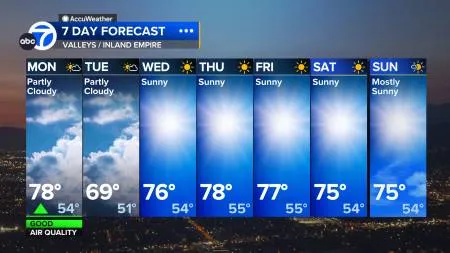 Detailed 7-day los angeles weather forecast for the Valleys and Inland Empire
Detailed 7-day los angeles weather forecast for the Valleys and Inland Empire
For those interested in outdoor activities, the los angeles weather plays a big role. Hiking trails in places like Runyon Canyon or the Santa Monica Mountains are best enjoyed during cooler parts of the day or year to avoid heat exhaustion. Beach activities are popular year-round, but the ocean water is warmest in late summer and early fall. Winter can bring powerful surf conditions, attracting experienced surfers.
Cultural events, outdoor concerts, and sports games are held throughout the year, and while most are designed to accommodate typical LA conditions, unexpected rain or heatwaves can occasionally impact plans. Always check the specific event details and be prepared for variable conditions based on the time of year and location within the city. Packing layers is almost always a good strategy when visiting Los Angeles due to the microclimates and potential for temperature swings throughout the day.
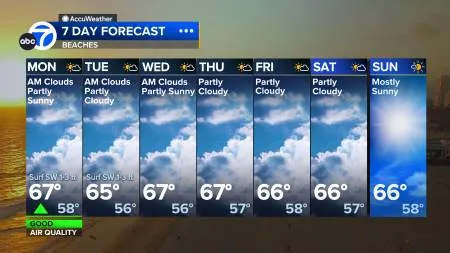 Detailed 7-day los angeles weather forecast for the Beaches
Detailed 7-day los angeles weather forecast for the Beaches
From a culinary perspective, the climate even influences the food scene. The year-round mild weather supports incredible local produce, contributing to California’s farm-to-table movement. Outdoor dining is a staple in Los Angeles, and the pleasant los angeles weather most of the year allows for enjoying everything from street tacos to fine dining al fresco. Even on cooler or cloudy days, a patio with heaters is a common and welcome sight.
Historically, the climate has shaped the development of Los Angeles, from its early agricultural roots to its appeal as a destination for health and wellness in the late 19th and early 20th centuries. The consistent sunshine was a major draw for the burgeoning film industry, needing reliable light for outdoor shoots. Understanding the climate helps appreciate the city’s past and its present lifestyle. Los Angeles continues to be defined by its climate, influencing everything from architecture to daily routines.
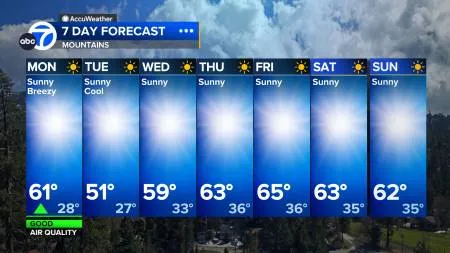 Detailed 7-day los angeles weather forecast for the Mountains
Detailed 7-day los angeles weather forecast for the Mountains
Whether you’re catching a Dodgers game, exploring the Getty Center, or hitting the waves, staying informed about the los angeles weather forecast will enhance your visit. Remember to check localized forecasts for the specific areas you plan to visit, as conditions can vary widely. Sun protection is advisable year-round, even on cloudy days, due to the strong California sun.
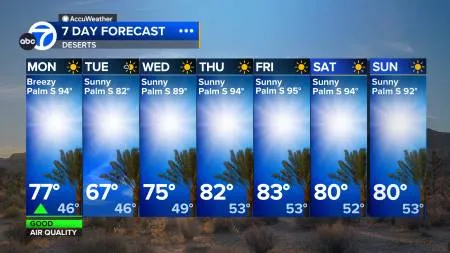 Detailed 7-day los angeles weather forecast for the Deserts
Detailed 7-day los angeles weather forecast for the Deserts
Frequently Asked Questions About Los Angeles Weather
Q: Is Los Angeles always sunny?
A: While Los Angeles is known for its sunshine, it’s not always sunny. Coastal areas frequently experience morning fog or the marine layer, particularly in late spring and early summer. Winter months can also bring cloudy days and rain.
Q: What are the microclimates in Los Angeles?
A: Due to its diverse geography, LA has several microclimates. Coastal areas are cooler and foggier, the downtown basin is a mix, valleys and inland areas are hotter in summer and colder in winter, and mountains are cooler with potential for snow in winter.
Q: When is the best time to visit Los Angeles based on weather?
A: Generally, spring (April-May) and fall (October-November) offer the most consistently pleasant los angeles weather with mild temperatures and clear skies. Summer is hot and dry, while winter is mild but can be rainy.
Q: How does the marine layer affect Los Angeles weather?
A: The marine layer is a layer of cool, moist air from the ocean that can cause morning fog or low clouds, especially in coastal and basin areas. It usually burns off by the afternoon, but in late spring/early summer (“May Gray,” “June Gloom”), it can persist longer.
Q: Do I need to pack a jacket for Los Angeles?
A: Yes, even during warmer months, evenings can cool down, especially near the coast or in the valleys. A light jacket, sweater, or layers are recommended, as temperatures can fluctuate throughout the day and between different areas.
In conclusion, keeping an eye on the los angeles weather forecast is an essential part of planning any trip to this dynamic city. Whether you’re chasing sunshine, seeking cool breezes, or just navigating daily life, understanding the local climate will help you make the most of your experience and truly connect with the rhythm of Southern California.
